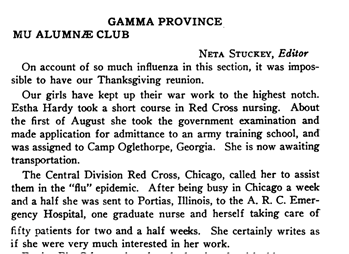A CENTURY LATER
The following post was written by Ellen Wenzel, Delta Xi–Arizona State University.
From the Spanish Flu of 1918 to COVID-19, women during each of these public health crises were shaped by the world around them, though it seemingly changed instantly. A century has passed from the Influenza Pandemic of 1918 to when the novel coronavirus was first detected in 2019, but many commonalities remain—including the impact made by women.
The 1918 Influenza was caused by a particularly virulent H1N1 virus, raged in four separate waves between February 1918 to April 1920. Worldwide estimates are that some 50 million people lost their lives—including nearly 725,000 in the United States and Canada. By comparison, the novel coronavirus, commonly known as COVID-19, has claimed more than 500,000 American lives and nearly 23,000 in Canada.
While similar attempts were made to control both pandemics—such as social distancing, restrictions on social gatherings and school cancellations—it is the personal stories of women who worked behind the scenes in 1918 that illustrate the burden carried by women as they filled many roles that would have ordinarily been worked by men had they were not serving in World War I.

The American Red Cross saw tremendous growth during World War I as its volunteer roster swelled to include some 8 million women. When the 1918 Influenza pandemic struck, then US Surgeon General, Rupert Blue requested the American Red Cross take the reins to recruit and assign medical workers.
As the American Red Cross had previously seen the positive impact of women’s volunteerism, they immediately called upon women for help. In addition to taking care of their own families and communities, a great number of women worked with the Red Cross as nurses and aides.
Women also served in canteens, made masks, assembled medical devices and garments, or served with teams providing transportation of those supplies. Those who could not aid on the front lines raised money through the sale of bonds to support American Red Cross efforts.
Grace Reed Sell, Eta–DePauw University
Grace, a college student who was stricken with influenza while at school, returned in 1918 just after recovering—just in time to aid some of her Alpha Gamma Delta sisters living in the chapter home.
After being contacted by the American Red Cross in Indianapolis, she spent several weeks on the front lines caring for patients. Unfortunately, Grace fell ill again in May 1919. Following her recovery, she completed her education and continued caring for influenza patients in the emergency room.
Among these women were members of Alpha Gamma Delta. Here are a few of their stories:

Esther Hardy Halsey, Mu–Brenau University
In August 1918, Esther took a Red Cross training course in nursing. Following testing to gain admittance to the Army Training School, she was recruited by the Red Cross’ Central Division in Chicago to aid in the pandemic. Esther and another nurse cared for more than 50 patients in just two weeks.

Maud Rose Stone, Beta–University of Wisconsin
During the pandemic, Maud Rose served in Pueblo, Colorado, as a school nurse. She provided care for children with influenza, scarlet fever and smallpox.
Madge Runey, Beta–University of Wisconsin
Madge served as a draft registrar during the epidemic. She traveled between families—particularly of German-Russian descent—performing various duties. As many fell in her community, she filled multiple roles when they could not attend their jobs. She contracted influenza in the early months of 1920.
Ruth Tingley, Theta–Goucher College
Ruth served as a staff worker for the Red Cross Home Service.

Marian Durning Russell, Nu–Boston University
Marian served as the Senior Executive of the Boston University Chapter of the Red Cross.
Pandemics have the forcible ability to shape and influence our lives on many levels. Everything from collegiate life to our home and social lives changed overnight. Thankfully, we have the luxury of technology to keep us more closely connected this time around. While the lives of Alpha Gams were lost to both pandemics, we are eternally grateful to the Alpha Gams serving medical workers, first responders and other essential workers who have sacrificed so much to contribute to the world’s work.

